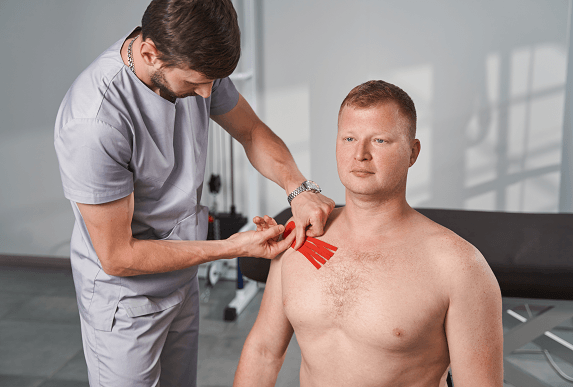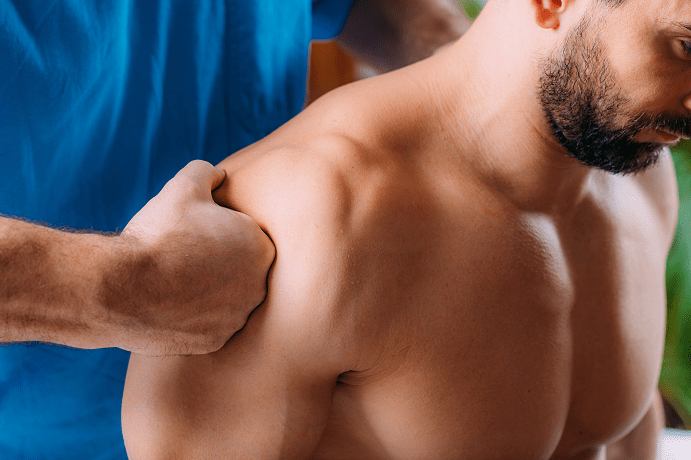Online Enquiry Form

Overview
A shoulder dislocation is a common shoulder condition in the under 30’s, whereby the “ball” of the upper arm becomes unstable in the “socket” of the shoulder. Dislocated shoulders are often caused by sports or play activities, especially those involving trauma, impact or repetitive, jerky movements. Damage can occur to the soft ring of tissue known as the labrum, which helps to stabilise the ball within the socket. If the cause of the condition is such that the arm stretches the shoulder joint and comes back to the socket, the injury is known as a partial shoulder dislocation or subluxation. If the cause of the condition causes the arm to completely fall off the socket, then the condition is known as complete shoulder dislocation. Shoulder dislocation is categorised according to type, and location.
Partial Shoulder Dislocation
The arm over stretches the shoulder joint and comes back to the socket.
Complete Shoulder Dislocation
The arm completely falls off the socket.
SLAP Tear
Top of the shoulder.
Bankart Lesion
Front of the shoulder.
Posterior Labral Tear
Back of the shoulder.

Causes
Shoulder dislocation may be caused by:
- A large impact force to the shoulder from behind.
- An awkward twisting arm movement.
- A combination of both.
Partial shoulder dislocation or subluxation injury is typically caused by repetitive arm movements, like pitching a ball or pulling a rope, that stretch the shoulder labrum. These types of injuries are often slow-onset injuries that worsen over time, however, if the movement is forceful enough, they may cause immediate pain and instability.
Complete shoulder dislocation injury is caused by receiving a direct impact to the shoulder from in front or behind or from falling on an outstretched arm or elbow, where a large amount of force causes complete dislocation of the ball from the socket of the shoulder.
Shoulder dislocations can also be caused by sports injuries, workplace injuries, chronic shoulder pain and degenerative joint disease.
Diagnosis
To diagnose a shoulder dislocation, the following will be taken into consideration:
- Understand the nature of the injury (sports, work, accident, overuse etc).
- Determine the cause of the injury (impact, collision, fall, repetitive/slow onset).
- Understand the context of the suffering (age, return to sport, work, impact on daily living).
- Perform a physical examination to ascertain pain and stability.
- Perform specialised shoulder tests to confirm diagnosis.
Partial Shoulder Dislocations
Partial shoulder dislocations are often painful and the arm can be weak or unstable when moving in the direction of the injury. Tests such as the shoulder apprehension test are used to confirm suspected shoulder dislocation injuries.
Complete Shoulder Dislocations
Complete shoulder dislocation is obvious as the patient will be unable to move their arm at all. Pulse and wrist sensation, in comparison to the unaffected side, are useful checks to determine the extent of the injury. xray, MRI and diagnostic tests are used to uncover the presence of fractures, their severity and size and location of the suspected labral injury.
SLAP Tear
SLAP tears are common shoulder conditions in patients older than 40 who perform regular above shoulder height activities. SLAP stands for Superior Labral tear from Anterior to Posterior, a tear to the labrum at the top of the shoulder socket in a direction from front to back. SLAP tears are mostly shoulder subluxation injuries and may involve associated conditions of the shoulder such as tendonitis to the long head of biceps tendon and rotator cuff tear.
Bankart Lesion
Bankart lesion injuries are common in younger athletes from 15-35 years old who partake in contact sports such as rugby league, American football and mixed martial arts. A Bankart lesion refers to a labral tear at the front of the shoulder socket. Bankart lesions may also be associated with bony Bankart lesions or Hills Sachs lesions whereby fracture to either the shoulder socket or ball of the upper arm occurs at the same time as shoulder dislocation.
Posterior Labral Tear
A posterior labral tear, or reverse Bankart lesion, is a tear at the back of the shoulder socket, often causing a partial as opposed to a complete dislocation. Common in a car accidents and fall injuries, posterior labral tears often present with associated rotator cuff tear or broken collar bone due to the nature of the impact.

Treatment
Non-Surgical Treatment
All shoulder dislocations need to be relocated back into the shoulder joint and immobilised for up to 6 weeks. Depending on the severity of the condition, the usual pathway of treatment follows:
- Relocation of the shoulder.
- Rest and immobilisation in a sling.
- Pain and anti-inflammatory medications.
- Consideration for surgery.
- Physiotherapy rehab protocol.
Surgical Treatment
Shoulder dislocation injuries may require surgery if you wish to return to high-demand activities. There are different surgical operations available to suit your age and level of activity you wish to return to.
Labral Repair
This procedure is a useful surgical repair for those who have been diagnosed with SLAP tear, Bankart tear or posterior labral tear. The keyhole procedure involves visualising the tear, using small instruments to catch and sew up the tear, and an orthopaedic anchor to fix or stabilise the repaired labrum back to the socket of the shoulder.
Latarjet Stabilisation
This procedure is reserved for those who have suffered bony loss due to a bony Bankart tear during shoulder dislocation and in instances where the patient wishes to return to contact sports. The labrum is reinforced with a bony block taken from the coracoid process of the patient, which replaces lost bone and adds additional stability to the shoulder socket.
Arthroscopic Shoulder Stabilisation Surgery
This surgical procedure reduces the stretched shoulder capsule and reattaches the torn labrum.
Latarjet Surgical Procedure
This surgical procedure removes bone from another part of the shoulder and attaches it to the front of the shoulder. Often used for recurrent dislocations and patients wishing to return to contact sports.

Post Operative Rehabilitation
You will achieve the best surgical outcome if you follow up surgery with a matching course of rehabilitation. Following surgery, Dr Gupta will outline the most appropriate rehabilitation protocol for your physiotherapist to follow and communicate with your healthcare team to ensure that you receive the best post-operative treatment.
Please contact our friendly team on 02 9687 8344 or make an online enquiry here.

Dr Manish Gupta | MBBS FRACS FAOrthoA
Dr Manish Gupta is a renowned expert surgeon in the field of orthopaedic surgery specialising in upper limb including shoulder, elbow and wrist.